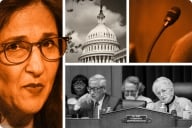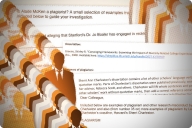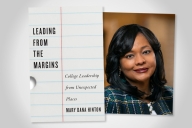You have /5 articles left.
Sign up for a free account or log in.
Discussions about trigger warnings now almost need trigger warnings, they’ve become so divisive. A new volume by an initially skeptical academic doesn’t settle the great trigger warning debate, but it does attempt to bring history, theory and context to it (titularly and otherwise).
Trigger Warnings: History, Theory and Context was published recently by Rowman & Littlefield. Editor Emily J. M. Knox, an assistant professor of information sciences at the University of Illinois at Urbana-Champaign, solicited essays from as many academic Listservs as she could find, as well as from colleagues within her field of library and information sciences and on social media. Crucial to the project was a variety of perspectives on what trigger warnings are, what they mean to academe and how and whether to use them. Contributing authors include those with library and information science, communications studies, gender studies, anthropology, political science, and law backgrounds.
“I have my own feelings about trigger warnings, but I thought it was important to have a lot of different voices from different fields,” Knox told Inside Higher Ed. “The controversy over trigger warnings also always seemed somewhat ahistorical to me -- as if trigger warnings suddenly appeared on websites and then moved to college campuses. I wanted the book to provide more context for understanding the debate.”
So it does. Knox begins with her own history as someone predisposed to hating “labels” for literature. That's based on her background in library and information sciences, in which more access to information is always better. She remains “ambivalent” about trigger warnings even after editing the book, but she does describe a slight lukewarming to the idea.
Knox tells of teaching a survey course on information policy that includes a discussion of digital labor. One of the assigned readings is a bluntly titled 2014 Wired piece, “The Laborers Who Keep Dick Pics and Beheadings Out of Your Facebook Feed.” The article describes the work of screening and censoring material for social media, performed mostly by laborers in developing nations -- many of whom suffer post-traumatic stress from looking at images such as child pornography day in and day out.
Knox didn’t offer her students a heads-up before they read the article, even though it included some graphic descriptions of the pictures in question. Did she make the right choice? She still doesn’t know; the gruesome photos were not the central part of the story -- the workers were. Yet next time she assigns the reading, she says, she will offer a heads-up that some imagery might be disturbing.
Why? “My primary research area is in intellectual freedom and censorship, and I think a lot about the power of reading and how texts can change lives. In many ways, trigger warnings are an acknowledgment of that power,” Knox said in an interview.
She added, “My basic feeling is that trigger warnings are about relationships. I want to have a good relationship with my students and I care about them, so giving a trigger warning is an important way to enact that.” At the same time, she said, she wouldn’t call it a “trigger warning” by name. That’s because the term has become “so political that I think we’ve forgotten that what we’re actually talking about is the people in our classrooms and the varied experiences that they bring with them.” (Knox also notes in her book that trigger warnings often relate to content from marginalized groups who have lived traumatic experiences -- i.e., stories that need to told and heard, not censored.)
What is a trigger warning? Knox notes that The Oxford English Dictionary defines it as “a statement at the start of a piece of writing, video, etc. alerting the reader or viewer to the fact that it contains potentially distressing material.” That’s compared to “content notes,” she says, which warn the reader of material that might contain less traumatic information. Yet many people -- including some of the book’s contributors -- use the two terms interchangeably, she says.
‘Rival Histories’
The rest of the book is divided into two parts: history and theory, and case studies. Again, the former section by no means settles the debate and even presents what Knox calls “rival histories” of trigger warnings. Indeed, the book defies the now-common notion that trigger warnings originated on feminist blogs. One chapter, for example, begins with a discussion of "war neurosis" in the soldiers of ancient Greece and Rome; it argues that trigger warnings can't be understood without first understanding the history of PTSD and trauma more generally. Another chapter portrays trigger warnings as an historical human rights-oriented accommodation to those who have experienced trauma, while yet another legal analysis argues that the research on the effectiveness of trigger warnings is so thin that First Amendment arguments against them will always trump accommodation arguments for them. Several scholars, one at length, note that trigger warnings have long been used in discussions about eating disorders. Several chapters focus on the idea that trigger warnings are fundamentally about the construction of audience.
So when did they become so controversial? Bonnie Washick, a postdoctoral research associate in political science and women’s and gender studies at Illinois, argues it was “students’ advocacy of trigger warnings as a systemic solution that elevated trigger warnings to a topic of national debate.” More precisely, she says, “it was the articulation of affinities between trigger warnings as a tool of equal access and the institutionalization of the Americans With Disabilities Act; Title IX [of the Education Amendments of 1972], which bars discrimination on the basis of sex; and diversity on college campuses that made it possible to imagine that the use of trigger warnings could come to be required, expected or simply normal.”
That’s a position echoed somewhat by Barbara Jones, former director of the American Library Association’s Office for Intellectual Freedom and executive director of the Freedom to Read Foundation, in her chapter on helping write the American Association of University Professors’ statement opposing mandatory trigger warnings.
“The latest policy for creating a safe, inclusive campus environment has been trigger warnings,” Jones wrote, noting that research suggests trigger warnings are student-, not faculty-driven. “What began as a PTSD diagnosis for returning veterans and victims of violent assault has been extended … to any number of traumatic events that are very real but arguably different (for example, the undercurrent of racial bias on campus) and require different treatment.”
Policy and Practice
Jones, like several other contributors, references Oberlin College’s short-lived trigger warning guidance as a kind of cautionary tale for writing trigger warning policy (it was widely seen as too broad and potentially punitive to professors who didn’t follow it, though the college has argued it was never forced on anyone). She offers several additional points of advice for writing policy, such as preserving the U.S. tradition of academic freedom and considering that students come to college with diverse background but also that those who request trigger warnings might have deeper concerns about campus climate. Trigger warnings are just one tool among many to create an inclusive campus, she says, and “trigger warnings are a quick fix for a systemic problem.”
Ultimately, Jones says, trigger warnings “are so much like book banning. Many well-meaning people challenge books because they want to help in one small way with a contemporary problem. It might be teen suicide. It might be racism. It is their way of expressing their concern in making the world a better place.” Yet “they must be shown that censorship creates barriers for others. And to remove themselves to a safe space is a real loss to dialogue. Avoiding a topic does not make it go away. In fact, engaging in uncomfortable content, at college, where one is surrounded by peers and support groups, is the best way.”
Case studies include one of the University of Kentucky's institution-wide trigger warning for Picking Cotton: Our Memoir of Injustice and Redemption, a recent pick for a common reading program for new students. The book includes a graphic firsthand account of a rape and discussions of racial discrimination, the university was concerned enough to issue a "note" to the campus. It said, in part, that Picking Cotton needs to be read and utilized on campus with great sensitivity due to the issues it raises, such as sexual assault and racial dynamics. The book carries a trigger warning." Cards saying the same were distributed in student copies of the book, and Kentucky's president, Eli Capilouto, even recorded a YouTube message about it.
Authors of the chapter, Joe C. Martin and Brandy N. Frisby, both faculty members in instructional communication at Kentucky, surveyed student and professors involved in the reading program, and the faculty members in particular had widely varied responses to the institution's warning. One professor was pragmatic, for example, saying if it helps students, it can't hurt. Another expressed concern that if a student asked for an alternate reading assignment due to a personal experience with rape, any professor would have to report the alleged assault due to mandated reporter policies applicable to faculty members.
Martin and Frisby conclude that for those working in academic contexts, "regardless of their opinion on such warnings (or even their willingness to use them at all), cannot avoid the reality of trigger warnings." While the future of trigger warnings isn't yet clear, they say, "their influence in this present moment is clearly apparent."
Pinky Hota, an assistant professor of anthropology at Smith College, meanwhile, argues that the harshest critiques of trigger warnings draw gendered connections between emotional language and the language of trauma, "thereby attempting a pejorative feminization of minority speakers who dare lay claim to pasts marked by historical oppression and reducing structural and political injury to individual pathology." She recalls the harsh criticism Smith’s students received for protesting the planned 2014 commencement address by Christine Lagarde, head of the International Monetary Fund, for example. After Lagarde backed out to preserve the “celebratory” spirit of the day, Hota says that students’ potentially legitimate criticisms of IMF policy were disregarded by critics who sough to portray “academic freedom and free speech as dangerously compromised on American campuses.” Ultimately, Hota doesn't endorse trigger warnings or reject them, but asks whether colleges and universities should train students to withstand "masculinist liberal ideals" against trigger warnings or instead craft new feminist pedagogical practices (which would, presumably, welcome such warnings).
Hota said via email that she wanted to contribute to Knox’s book both to play “devil’s advocate” on trigger warnings and to challenge her own thinking about them. She has the same goal for readers.
“I want people to critically interrogate their assumptions about trigger warnings as merely another symptom of the endemic vulnerability of our students, in a higher education climate characterized by the grooming of students as consumers while critiquing them for being wholly apolitical,” she said. “I want readers to contemplate trigger warnings as the starting point of thinking of new and emergent forms of politics on campuses, that invite us to interrogate normative and long-cherished liberal ideals such as free speech.”
Kristina Ruiz-Mesa, an assistant professor of communication studies at California State University, Los Angeles, who co-wrote a chapter advocating trigger warnings, had a similar perspective -- albeit from a personal standpoint, not a political one.
“I often hear arguments claiming that trigger warnings are just another way to coddle students, and I think that this is an incredibly limited perspective,” she told Inside Higher Ed, “and one that casts instructors as toughening agents rather than educators. It’s not my job to toughen up students, it is my job to teach them. For many students, life experiences have made them tougher than we know.”
Noting that her classes include student speeches on everything from gun control to assault, Ruiz-Mesa said she sees trigger warnings “as a teaching tool to help minimize psychological noise that can disrupt student learning.”









